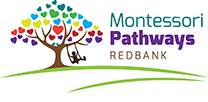Practical Life
The practical activities are the first activities the child is introduced to in the Montessori environment, because they can immediately begin to satisfy the young child’s inner desire for skills and self-sufficiency. They allow the child to try doing what adults do every day. These activities are designed to give the child real life experience and the tools should be real working tools, but should be child-sized. Each activity has it’s own place and all the items necessary for each activity are kept together. The child conducts the practical activities for the sake of working through their processes, rather than for the sake of their results. Later, the products of practical life activities become useful, as the children realise they are responsible for their own environment.
Language
The child’s acquistion of speech is a natural part of growing up human. This is not true of writing and reading, which is a cultural adaptation of speaking and must be cultivated or taught. This is the purpose of the language activities and the strategy used by Montessori is to build on the sounds of which speech is made. Preparatory language activities such as the classified pictures and I spy augment the child’s existing speaking skills. After this , writing and reading activities are conducted simultaneously.
Sensorial
The primary purpose of the sensorial activites is to assist the child’s efforts to sort out the many and varied impressions given by the senses. This is achieved by developing, ordering, broadening and refining sense perception. Sense perception is developed through exercises that build from simple to complex perceptual experiences. Ordering occurs as each apparatus isolates a single perceptual quality such as colour or taste and explores a range of differences within that quality. The child’s perception of the world is broadened by awaking sense experiences previously unexplored e.g. the feel of fabrics or the smell of spices. Sense perception is refined as the child concentrates on particular qualities in perfect clarity and isolation.
Mathematics
To many, mathematics is a cold and inhuman pursuit with abstract symbols, unbending laws and sterile logic. we should help the child understand that part of being human is having a mathematical mind and that we make mathematics every time we move, think, work or play. The foundation of our mathematical mind is to idealise the world e.g. the idealisation of form leads to the study of geometry.To further our understanding, basic intellectual skills area also necessary, such as judging relatitive amounts of degrees and perceiving exactness. The practical and sensorial activities prepare the child for the study of Mathematics. The mathematical activities include introduction to numbers, the decimal system, teens, tens and counting, arithmetic tables and abstraction.
Cultural Arts & Science
Humans have art, religion laws, scientific pursuits and recorded language, which can be summed up as ‘culture’. Montessori identified fourteen specific behavioural traits which she called the ‘tendencies of man’. They are: exploration, order, gregariousness, communication, abstraction, curiousity, calculation, work aided by repetition, concentration and self control, creativity and independence. These tendencies operate upon our behaviour and are apparent in our cultural or (adaptive) activities e.g. Geography is based on the tendency to explore. The Montessori cultural studies include the areas of Geography, History, Zoology, Botany, Human biology, Music and Art.
